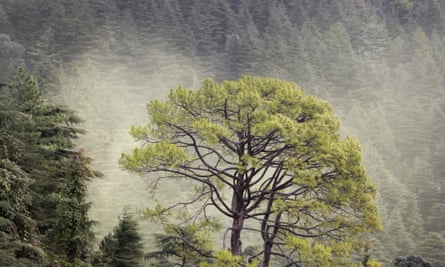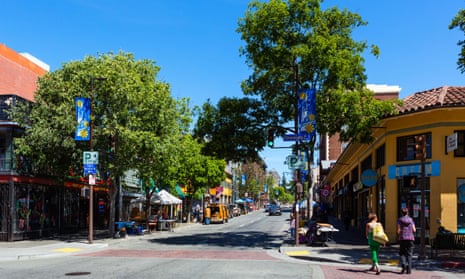Eight years ago Tom Ogren, a horticulturist, was in Sacramento, California, when he noticed that the ground around the State Capitol building was covered in thick yellow pollen.
Scanning the trees along the street with his binoculars, he saw the trees were all deodar cedars (Cedrus deodara) and all cultivated males.
Naturally, the deodar is monoecious, having both male and female cones growing on the same tree. But cultivation has produced wholly male trees – plants favoured by planners since they have no seeds or pods to drop but only pollen. This was the case at this Sacramento site, Ogren said.
Growers’ breeding of purely male diodar trees had created, said Ogren, “something that doesn’t even exist in nature”.
Ogren said he had seen similar pollen-coated cityscapes in Christchurch, New Zealand, London, UK, and all over Canada. “Everywhere I’ve gone, same situation,” he said.
Male trees are often favoured by urban landscape planners as female trees can shed fruit as well as seeds and pods.
Pollen producing trees that are dioecious (with male and female flowers on separate plants) are seen to add to the effect of allergies of city dwellers .
Today, hay fever affects more than 400 million people worldwide. More than 300 million people have asthma, often an effect of hay fever, and that number is expected to rise by 100 million by 2025.
Allergenic tree pollen was found to be one of the biggest contributors to hay fever and asthma, and pollen counts have also been rising over the past 15 years.
This health issue is going largely unaddressed despite there being a simple solution: a bigger mix of male and female trees in urban areas.
While some cities were beginning to catch on, Ogren said, getting the methodology widely adopted was an uphill battle.
He began researching allergenic plants and trees more than 30 years ago, when, with his wife, he moved to San Luis Obispo, California. His wife developed terrible allergies, he said. After studying the flora in their neighbourhood he understood the reason – all the tree species were males.
Trees can be one of three sexes – monecious, dioecious male or dioecious female. Naturally, there is a relatively even split between all three, so the amount of pollen wafted into the air is regulated. But when dioecious males are planted independently of dioecious females, as often the case in urban areas, their pollen is unchecked by any capture by female flowers.

Landscape plans of cities across the US revealed the planting pattern to Ogren. When he dug deeper he found a note in the 1949 USDA Yearbook of Agriculture reading: “When used for street plantings only male trees should be selected, to avoid the nuisance from the seed.” He said it was “botanical sexism”.
Ogren added that when Dutch elm disease wiped out a portion of America’s elm trees in the late 1960s urban landscapers ordered more than 100 varieties of male maple clones as replacements; then other male varieties followed. Since cloning proved quicker than waiting for trees to pollinate and grow naturally, male clones began to dominate the tree nurseries too. It was not just in the US. Ogren saw the same trend wherever he travelled.
By 2000 Ogren had collected so much data on tree species he was able to create his Ogren Plant Allergy Scale (Opals). It was the first numerical ranking system in existence for plant allergies. It is now used by the USDA Urban and Community Forestry programme to develop allergy rankings in large US cities.
Nigel Clarke, one of the UK’s largest distributors of female trees, met Ogren at a plant workshop in Guernsey and they began to help each other with a mutual mission – mitigation of urban tree pollen.
“If plant distributors, by their plant choices, are responsible for the rising numbers of allergy sufferers in urban areas, then we, by making the correct plant choices, can at least reduce the amount of allergenic pollen in the air,” said Clarke. Now, he said, he tagged all his trees using Opals to ensure his buyers were better informed.
Ogren’s work has also had an impact in several cities in Canada, where he was commissioned to do a tree allergy audit. The town of Hamilton, for example, has adopted more allergy-friendly urban planting policies, largely due to Peter Prakke, a nurseryman who has been advocating allergy-free schoolyards and public parks for the past 10 years, using Ogren’s work as a guide.
“Long story short, the school board accepted the Opals concept,” said Prakke “This was the first school board [to do so] in Canada.”
Vancouver, Edmonton and Halifax are also working towards balancing their tree populations so as to reduce allergies. But these are only small pockets of success.
Clifford Bassett, founder of Allergy and Asthma Care, of New York, said: “I see a growing number of patients each year who suffer from seasonally triggered allergies. Warmer temperatures, the longer pollen season, and rising carbon dioxide levels are likely to contribute to increasing sensitisation to pollen.”
Studies have shown that air pollution particulates attach to pollen grains, which causes the powdery substance to shatter into still tinier pieces. “When that happens the inside of the pollen grain is exposed and that’s 10 times more allergenic than the outside,” explained Ogren.
Higher CO2 levels also cause plants to bloom more, which means even higher pollen counts where predominantly male trees reside. If cities do not take action to slow this snowball effect, “we’re coming up with a recipe for terrible [allergy] disasters in the future”, said Ogren.
Ogren suggested that all sufferers should get together and “demand protection” as “a basic human right”, adding: “We could have pollen-free lawns, hedges, trees, all of this, it’s all doable, but only if enough people know about it and if the right people raise enough fuss about it.”
